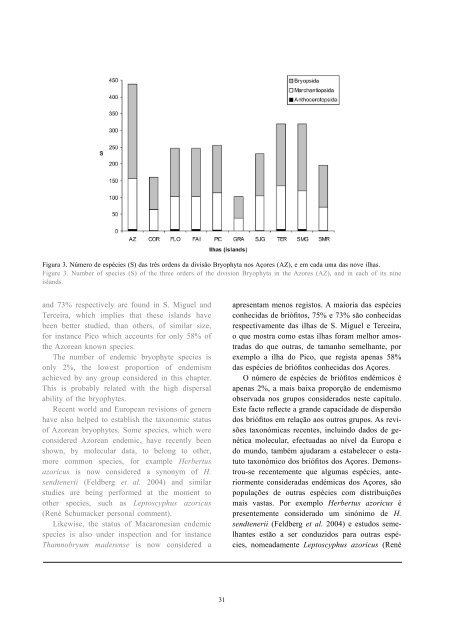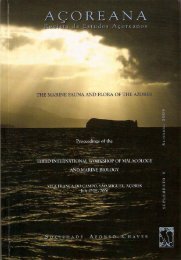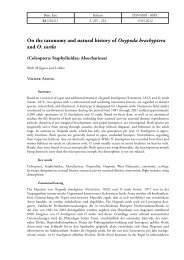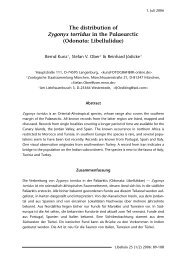(eds.) (2005). - Portal da Biodiversidade dos Açores - Universidade ...
(eds.) (2005). - Portal da Biodiversidade dos Açores - Universidade ...
(eds.) (2005). - Portal da Biodiversidade dos Açores - Universidade ...
Create successful ePaper yourself
Turn your PDF publications into a flip-book with our unique Google optimized e-Paper software.
Figura 3. Número de espécies (S) <strong>da</strong>s três ordens <strong>da</strong> divisão Bryophyta nos <strong>Açores</strong> (AZ), e em ca<strong>da</strong> uma <strong>da</strong>s nove ilhas.<br />
Figure 3. Number of species (S) of the three orders of the division Bryophyta in the Azores (AZ), and in each of its nine<br />
islands.<br />
and 73% respectively are found in S. Miguel and<br />
Terceira, which implies that these islands have<br />
been better studied, than others, of similar size,<br />
for instance Pico which accounts for only 58% of<br />
the Azorean known species.<br />
The number of endemic bryophyte species is<br />
only 2%, the lowest proportion of endemism<br />
achieved by any group considered in this chapter.<br />
This is probably related with the high dispersal<br />
ability of the bryophytes.<br />
Recent world and European revisions of genera<br />
have also helped to establish the taxonomic status<br />
of Azorean bryophytes. Some species, which were<br />
considered Azorean endemic, have recently been<br />
shown, by molecular <strong>da</strong>ta, to belong to other,<br />
more common species, for example Herbertus<br />
azoricus is now considered a synonym of H.<br />
sendtenerii (Feldberg et al. 2004) and similar<br />
studies are being performed at the moment to<br />
other species, such as Leptoscyphus azoricus<br />
(René Schumacker personal comment).<br />
Likewise, the status of Macaronesian endemic<br />
species is also under inspection and for instance<br />
Thamnobryum maderense is now considered a<br />
31<br />
apresentam menos registos. A maioria <strong>da</strong>s espécies<br />
conheci<strong>da</strong>s de briófitos, 75% e 73% são conheci<strong>da</strong>s<br />
respectivamente <strong>da</strong>s ilhas de S. Miguel e Terceira,<br />
o que mostra como estas ilhas foram melhor amostra<strong>da</strong>s<br />
do que outras, de tamanho semelhante, por<br />
exemplo a ilha do Pico, que regista apenas 58%<br />
<strong>da</strong>s espécies de briófitos conheci<strong>da</strong>s <strong>dos</strong> <strong>Açores</strong>.<br />
O número de espécies de briófitos endémicos é<br />
apenas 2%, a mais baixa proporção de endemismo<br />
observa<strong>da</strong> nos grupos considera<strong>dos</strong> neste capítulo.<br />
Este facto reflecte a grande capaci<strong>da</strong>de de dispersão<br />
<strong>dos</strong> briófitos em relação aos outros grupos. As revisões<br />
taxonómicas recentes, incluindo <strong>da</strong><strong>dos</strong> de genética<br />
molecular, efectua<strong>da</strong>s ao nível <strong>da</strong> Europa e<br />
do mundo, também aju<strong>da</strong>ram a estabelecer o estatuto<br />
taxonómico <strong>dos</strong> briófitos <strong>dos</strong> <strong>Açores</strong>. Demonstrou-se<br />
recentemente que algumas espécies, anteriormente<br />
considera<strong>da</strong>s endémicas <strong>dos</strong> <strong>Açores</strong>, são<br />
populações de outras espécies com distribuições<br />
mais vastas. Por exemplo Herbertus azoricus é<br />
presentemente considerado um sinónimo de H.<br />
sendtenerii (Feldberg et al. 2004) e estu<strong>dos</strong> semelhantes<br />
estão a ser conduzi<strong>dos</strong> para outras espécies,<br />
nomea<strong>da</strong>mente Leptoscyphus azoricus (René

















